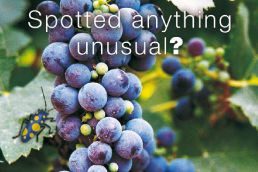 Australian Grape and Wine represents the biosecurity interests of wine grape producers and the industry. They are members of Plant Health Australia and signatories to the Emergency Plant Pest Response Deed. Their responsibilities include:
Australian Grape and Wine represents the biosecurity interests of wine grape producers and the industry. They are members of Plant Health Australia and signatories to the Emergency Plant Pest Response Deed. Their responsibilities include:
- biosecurity planning and implementation at the national and farm levels
- liaising with federal and state governments on trade issues
- funding and supporting biosecurity initiatives
- participating in national committees and response efforts in an emergency.
Industry overview
The wine industry has a significant footprint in Australia, with more than 6,000 wine grape growers, a vineyard area of 146,128 hectares, and 2,400 Australian wine producers blending grapes into wine. The most grown wine grape varieties are Shiraz (30%), Cabernet Sauvignon (18%) and Chardonnay (16%). The major varieties by colour are Shiraz, Cabernet Sauvignon and Merlot for reds and Chardonnay, Sauvignon Blanc and Semillon for whites.
The Australian wine industry has been fortunate to date in avoiding many of the world’s most devastating grape vine pests and as a result possesses some of the oldest vineyards in the world. Australia remains free from Xylella fastidiosa, and the industry continues to work hard to manage the spread of phylloxera. Australian grape and wine producers enjoy an enviable global reputation for producing high quality wines.
Australian Grape and Wine promotes biosecurity within the sector and the viticulture industry more broadly. Its Wine Biosecurity Committee provides a mechanism to coordinate and prioritise biosecurity work across the wine sector and to promote leadership. Australian Grape and Wine has worked to improve the sector’s capacity to respond to a pest or disease incursion through emergency response planning and training for industry personnel Australia-wide.
Biosecurity plans, manuals and resources
Expand
 Industry Biosecurity Plan for the Viticulture Industry
Industry Biosecurity Plan for the Viticulture Industry
Biosecurity planning provides a mechanism for the viticulture industry, government and other relevant stakeholders to assess current biosecurity practices and future biosecurity needs. Planning identifies procedures that can be put in place to reduce the chance of pests reaching our borders or minimise the impact if a pest incursion occurs.
The Biosecurity Plan for the Viticulture Industry provides a framework for biosecurity risk mitigation measures in the industry. For a copy, please contact PHA on 02 6215 7700 or email biosecurity@phau.com.au.
Click here for more information about planning.
Vineyard Biosecurity Manual
The Vineyard Biosecurity Manual contains information to help producers to implement biosecurity on-farm. Manuals usually contain an overview of biosecurity, fact sheets to identify the high priority pests of a crop, tips on crop management, and how to manage people, vehicles and equipment to minimise biosecurity risks.
Manuals also contain a biosecurity self-assessment list, and templates to record pest surveillance records and visitors. More information about on-farm biosecurity for both plant and livestock producers is available from the Farm Biosecurity website.
 Postcard
Postcard
Promotional item to support the exotic plant pest hotline 1800 084 881.
Pests
Expand
Exotic pests (not in Australia)
The following is a list of high priority exotic pests of the wine grape industry. These pests were identified during the development of the Biosecurity Plan for the Viticulture Industry in consultation with industry, government and scientists. They have been assessed as high priority pests based on their potential to enter, establish, and spread in Australia (eg environmental factors, host range, vectors) and the cost to industry of control measures.
PHA has a range of fact sheets, contingency plans and diagnostic protocols relevant to these pests. Pest risk review documents are also available for some pests. Please contact PHA on 02 6215 7700 or email biosecurity@phau.com.au for more information.
Endorsed National Diagnostic Protocols are available from the National Plant Biosecurity Diagnostic Network webpage.
Other pests
The following is a list of documents for other exotic and endemic pests of the wine grape industry. Please note that this is not a complete list of wine grape pests: rather it includes pests for which documents exist in the Pest Information Document Database.
Some of the documents presented here are not tailored to the wine grape industry and are included for information only.
 Australian Grape and Wine represents the biosecurity interests of wine grape producers and the industry. They are members of Plant Health Australia and signatories to the Emergency Plant Pest Response Deed. Their responsibilities include:
Australian Grape and Wine represents the biosecurity interests of wine grape producers and the industry. They are members of Plant Health Australia and signatories to the Emergency Plant Pest Response Deed. Their responsibilities include:
 Industry Biosecurity Plan for the Viticulture Industry
Industry Biosecurity Plan for the Viticulture Industry 




Recent Comments